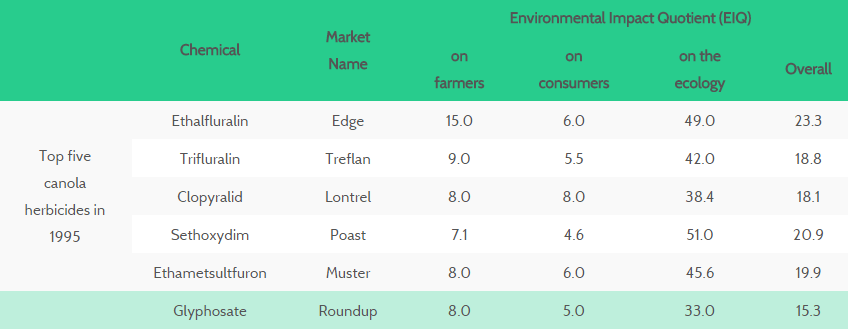Since the World Health Organization’s International Agency of Research on Cancer (IARC) decision to classify five pesticides as carcinogenic (last week’s SAIFood blog believes this is an error) there has been a hubbub around pesticide use, particularly glyphosate (Roundup). One message that the environmental movement is strongly advancing is that any chemical use in the production of crops and food products is extremely dangerous. Nothing could be further from the truth. Crop yields and production levels of today would not be possible without pesticides, especially glyphosate. The ability of Canadian agriculture to continually contribute to improving global food security depends on improving yields, lower cost through effective weed control and less soil disruption. To accomplish this agriculture must rely on the safe and efficient use of chemicals.
Changing the classification of glyphosate suggests to consumers that chemical use presents them with risks. Without balance, these stories could easily frighten consumer, it is regrettable, but consumers have very little awareness about the commonplace risks regarding food production and consumption. Yet this should come as no surprise, what items don’t present some form of risk in our everyday lives? Last week, I discussed some of the risks of organic foods with Dan Yates of The Western Producer. What it comes down to is that glyphosate is a chemical and individual risks vary by exposure as discussed last week. Handling Roundup requires precaution, which is no different than any other farm chemical use. So really how dangerous are chemicals like glyphosate?
Let’s put glyphosate’s use in agriculture into context. Glyphosate is an innovative technology that allowed other, more toxic, chemicals to be removed from use. In canola alone, glyphosate has helped to replace five chemicals which had higher environmental impact quotients (EIQ). An EIQ is the relative measurement of a chemical’s toxicity. Table 1 shows the EIQ of the top five canola herbicides in 1995 before the introduction of herbicide tolerant canola and in 2006 during which time glyphosate was the predominant canola herbicide. Compared to the top five herbicides of canola in 1995, glyphosate is less toxic on the environment, consumers, and producers in most cases.
Table 1: Environmental Impact Quotient of Canola Herbicides
| Chemical | Market Name | Environmental Impact Quotient (EIQ) | Environmental Impact Quotient (EIQ) | Environmental Impact Quotient (EIQ) | Environmental Impact Quotient (EIQ) | |
| on farmers | on consumers | on the ecology | Overall | |||
| Top five canola herbicides in 1995 | Ethalfluralin | Edge | 15.0 | 6.0 | 49.0 | 23.3 |
| Top five canola herbicides in 1995 | Trifluralin | Treflan | 9.0 | 5.5 | 42.0 | 18.8 |
| Top five canola herbicides in 1995 | Clopyralid | Lontrel | 8.0 | 8.0 | 38.4 | 18.1 |
| Top five canola herbicides in 1995 | Sethoxydim | Poast | 7.1 | 4.6 | 51.0 | 20.9 |
| Top five canola herbicides in 1995 | Ethametsultfuron | Muster | 8.0 | 6.0 | 45.6 | 19.9 |
| Glyphosate | Roundup | 8.0 | 5.0 | 33.0 | 15.3 |
The environmental impact of glyphosate is substantially lower than the chemicals it has replaced. However, over-reliance on the use of glyphosate needs to be carefully managed so that the superior weed control benefits of its use are not lost for farmers through the development of herbicide resistant weeds. The use of chemicals in the production of crops and foods contributes to successfully feeding a hungry world. Those that argue otherwise are intentionally misleading consumers.
It has been shown that removing the use of chemicals, such as much of organic production does, reduces crop yields by at least 30%. Those that advocate that the use of chemicals in the production of crops and food pose a danger to us as consumers are intentionally misleading all of us as they neglect to mention the pesky fact of 30% less food. I believe that the safe use of chemicals is important and increasing food insecurity for 30% of the planets population is not something that informed consumers would choose.


